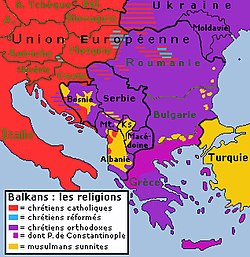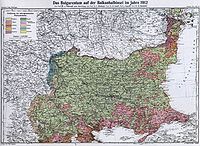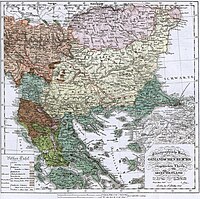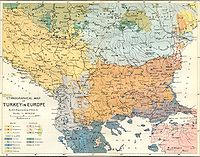バルカン半島
出典: フリー百科事典『ウィキペディア(Wikipedia)』 (2024/04/11 01:05 UTC 版)
人口統計
バルカンにはアルバニア人、アルーマニア人、ブルガリア人、ボスニャク人、クロアチア人、ゴーラ人、ギリシャ人、マケドニア人、モンテネグロ人、セルビア人、スロヴェニア人、ルーマニア人、トルコ人が居住し、さらにロマ人やアッシュカリーのようなその他の民族集団が現在、ある国で少数民族として存在している[40]。[出典無効]
| 国 | 人口(2018)[93] | 人口密度/km2 (2018)[94] | 平均寿命(2018)[95] |
|---|---|---|---|
 アルバニア アルバニア
|
2,870,324 | 100 | 78.34歳 |
 ボスニア・ヘルツェゴビナ ボスニア・ヘルツェゴビナ
|
3,502,550 | 69 | 77.2歳 |
 ブルガリア ブルガリア
|
7,050,034 | 64 | 79.9歳 |
 クロアチア クロアチア
|
4,105,493 | 73 | 76.2歳 |
 ギリシャ ギリシャ
|
10,768,193 | 82 | 80.1歳 |
 コソボ*[a] コソボ*[a]
|
1,798,506 | 165 | 77.7歳 |
 モンテネグロ モンテネグロ
|
622,359 | 45 | 76.4歳 |
 北マケドニア 北マケドニア
|
2,075,301 | 81 | 76.2歳 |
 ルーマニア ルーマニア
|
19,523,621 | 82 | 76.3歳 |
 セルビア セルビア
|
7,001,444 | 90 | 76.5歳 |
 スロベニア スロベニア
|
2,066,880 | 102 | 78.2歳 |
 トルコ トルコ
|
10,201,115[96][c] | 101 | 71.1歳 |
宗教

バルカンは正教会とイスラーム教、ローマ・カトリックの接点である[97]。正教会はバルカン半島・バルカン地域の最大宗派である。多様な信仰がそれぞれに異なる伝統を実践しており、正教会系の国々は各国が自身の国の教会(national church)を持っている。住民の一部には無宗教を自任するものもいる。
| 正教会が主要な宗教である地域(括弧内は国の教会)[98] | それらの地域の少数派宗教[98] |
|---|---|
| ブルガリア:94%(ブルガリア正教会) | イスラーム(2%)未申告(22%) |
| ギリシャ:98%(ギリシャ正教会) | イスラーム(1%)、カトリック、その他・未申告 |
| モンテネグロ: 72% (セルビア正教会) | イスラーム(19%)、カトリック(3%)、その他・未申告 (5%) |
| 北マケドニア:64%(マケドニア正教会) | イスラーム(33%)、カトリック |
| ルーマニア:81%(ルーマニア正教会) | プロテスタント(6%)、カトリック(5%)、その他・未申告(8%) |
| セルビア:84%(セルビア正教会) | カトリック(5%)、イスラーム(3%)、プロテスタント(1%)、その他・未申告(6%) |
| カトリックが主要な宗教である地域[98] | それらの地域の少数派宗教[98] |
| カトリック(86%) | クロアチアの正教会(4%)、イスラーム(1%)、その他・未申告(7%) |
| カトリック(57%) | イスラーム(2%)、正教会(2%)、その他・未申告(36%) |
| イスラーム教が主要な宗教である地域[98] | それらの地域の少数派宗教[98] |
| アルバニア(58%) | カトリック(10%)、アルバニアの正教会(7%)、その他・未申告(24%) |
| ボスニア・ヘルツェゴヴィナ (51%) | 正教会(31%)、カトリック(15%)、その他・未申告(4%) |
| コソヴォ(95%) | カトリック(2%)、正教会(2%)、その他・未申告(1%) |
| トルコ(99%) | 正教会 |
バルカンにおけるユダヤ人のコミュニティ、特に今日のギリシャ地方のそれはヨーロッパで最も古いもので古代にまで遡る[99]。トランシルヴァニア、クロアチア、スロヴェニアのユダヤ人コミュニティはアシュケナジー(東欧系)のものである。バルカンの多くの地域のユダヤ人はセファルディム(スファラディム、レコンキスタ後のスペインから追放、脱出したユダヤ人に起源を持つ[100])系である[99]。古くからバルカンに居住しギリシャ語を使用していたユダヤ人たちはロマニオテスと呼ばれたが、彼らの多くはセファルディムに同化した[99]。ボスニア・ヘルツェゴヴィナでは小さく密接に絡み合ったユダヤ人のコミュニティは90%がセファルディムであり、ラディーノ語(Ladino)は今なお高齢者の間で使用されている。サライェヴォにあるセファルディム系ユダヤ人の墓地は独特の形状の墓石を持っており、古代のラディーノ語が刻まれている[101]。セファルディム系ユダヤ人はかつてはテッサロニキで大きな存在感を有しており、1900年までは約80,000人、人口の半分以上がユダヤ人であった[102]。バルカンのユダヤ人コミュニティは第二次世界大戦の間、大きな苦しみを味わい、ホロコーストによって大部分が殺害された。例外はブルガリア系ユダヤ人で、彼らの大部分は強制収容所にユダヤ人を送ることに反対しアドルフ・ヒトラーに抵抗するブルガリア王ボリス3世によって保護された。バルカンのユダヤ人の僅かな生存者たちは(その後)ほとんどが新たに建国されたイスラエルかその他の地域に移住した。今日のバルカン諸国の大部分は重要性のあるユダヤ人少数派はほとんど存在しない。
言語



バルカン地方は今日、民族・言語的に非常に多様な地域であり、複数のスラヴ語とロマンス語を話す人々が住み、またアルバニア語、ギリシャ語、トルコ語、更にその他の言語も使用されている。ロマ語はバルカン諸国全体に居住するロマ人の大部分によって使用されている。歴史を通じて、多くの異なる民族的グループが自身の言語を用いてバルカンに居住していた。そうした人々にはトラキア人、イリュリア人、ローマ人、ケルト人、様々なゲルマン人の部族がいた。テュルク系言語を例外として、過去から現在に至る前述の言語群の全てが、より大きな括りではインド・ヨーロッパ語族に属する(テュルク系言語にはトルコ語、ガガウズ語がある)。
| 国 | 第一言語[103] | 少数派言語[103] |
|---|---|---|
 アルバニア アルバニア
|
98% アルバニア語 | 2% その他 |
 ボスニア・ヘルツェゴビナ ボスニア・ヘルツェゴビナ
|
53% ボスニア語 | 31% セルビア語、15% クロアチア語、2% その他 |
 ブルガリア ブルガリア
|
94% ブルガリア語 | 2% トルコ語、2% ロマ語、1% その他、1% 不明 |
 クロアチア クロアチア
|
96% クロアチア語 | 1% セルビア語、3% その他 |
 ギリシャ ギリシャ
|
99% ギリシャ語 | 1% その他 |
 コソボ*[a] コソボ*[a]
|
94% アルバニア語 | 2% ボスニア語、2% セルビア語、1% トルコ語、1% その他 |
 モンテネグロ モンテネグロ
|
43% セルビア語 | 37% モンテネグロ語(公用語)、5% ボスニア語、5% アルバニア語、5% その他、4% 不明 |
 北マケドニア 北マケドニア
|
67% マケドニア語 | 25% アルバニア語、4% トルコ語、2% ロマ語、1% セルビア語、2% その他 |
 ルーマニア ルーマニア
|
91% ルーマニア語 | 7% ハンガリー語、1% ロマ語 |
 セルビア セルビア
|
88% セルビア語 | 3% ハンガリー語、2% ボスニア語、1% ロマ語、3% その他、2% 不明 |
 スロベニア スロベニア
|
91% スロヴェニア語 | 5% セルボ・クロアチア語、4% その他 |
 トルコ トルコ
|
81% トルコ語 | 15% クルド語、4% その他・不明 |
都市化
バルカンの国々のほとんどは大部分都市化されており、総人口に対する都市人口の比率が最も低い諸国はコソヴォ(40%以下)、ボスニア・ヘルツェゴヴィナ(40%)、スロヴェニア(50%)[104]である。
各国の大都市の一覧:
| 都市 | 国 | 人口 | 都市圏人口 | 年次 |
|---|---|---|---|---|
| イスタンブル* |  トルコ トルコ |
9,000,000 | 10,000,000 | 2018[105] |
| ブカレスト |  ルーマニア ルーマニア |
1,887,485 | 2,272,163 | 2018[106] |
| ソフィア |  ブルガリア ブルガリア |
1,313,595 | 1,995,950 | 2018[107] |
| ベオグラード |  セルビア セルビア |
1,119,696 | 1,659,440 | 2018[108] |
| ザグレブ |  クロアチア クロアチア |
792,875 | 1,113,111 | 2018[109] |
| アテネ |  ギリシャ ギリシャ |
664,046 | 3,753,783 | 2018[110] |
| スコピエ |  北マケドニア 北マケドニア |
444,800 | 506,926 | 2018[111] |
| ティラナ |  アルバニア アルバニア |
418,495 | 800,986 | 2018[112] |
| プロヴディフ |  ブルガリア ブルガリア |
411,567 | 396,092 | 2018[107] |
| ヴァルナ |  ブルガリア ブルガリア |
395,949 | 383,075 | 2018[107] |
| テッサロニキ |  ギリシャ ギリシャ |
325,182 | 1,012,297 | 2018[110] |
| クルジュ=ナポカ |  ルーマニア ルーマニア |
324,576 | 411,379 | 2018[106] |
| ティミショアラ |  ルーマニア ルーマニア |
319,279 | 356,443 | 2018[106] |
| ヤシ |  ルーマニア ルーマニア |
290,422 | 382,484 | 2018[106] |
| コンスタンツァ |  ルーマニア ルーマニア |
283,872 | 425,916 | 2018[106] |
| リュブリャナ |  スロベニア スロベニア |
279,756 | 279,756 | 2018[113] |
| ノヴィ・サド |  セルビア セルビア |
277,522 | 341,625 | 2018[114] |
| サライェヴォ |  ボスニア・ヘルツェゴビナ ボスニア・ヘルツェゴビナ |
275.524 | 413,593 | 2018[要出典] |
| クラヨーヴァ |  ルーマニア ルーマニア |
269,506 | 420,000 | 2018[106] |
| チョルル |  トルコ トルコ |
253,500 | 273,362 | 2018[115] |
| ブラショヴ |  ルーマニア ルーマニア |
253,200 | 369,896 | 2018[106] |
- * イスタンブルのヨーロッパ部分だけがバルカンに属する[105]。イスタンブルの人口15,987,888人のうち3分の2がヨーロッパ部に居住している。
- ^ Colin S. Gray, Geoffrey Sloan (2014-01-14). Geopolitics, Geography and Strategy. ISBN 9781135265021 2014年11月10日閲覧。
- ^ “Balkans” (英語). Encyclopedia Britannica 2017年12月13日閲覧。
- ^ Richard T. Schaefer (2008). Encyclopedia of Race, Ethnicity, and Society. SAGE. p. 129. ISBN 978-1-4129-2694-2
- ^ a b c d e f g h Alexander Vezenkov (2017). “Entangled Geographies of the Balkans: The Boundaries of the Region and the Limits of the Discipline”. In Roumen Dontchev Daskalov, Tchavdar Marinov. Entangled Histories of the Balkans - Volume Four: Concepts, Approaches, and (Self-)Representations. BRILL. pp. 115–256. ISBN 978-90-04-33782-4
- ^ a b 柴 1998, p. 5
- ^ Olga M. Tomic (2006). Balkan Sprachbund Morpho-Syntactic Features. Springer Science & Business Media. p. 35. ISBN 978-1-4020-4488-5
- ^ マゾワー 2017, p. 6
- ^ Robert Bideleux; Ian Jeffries (2007). The Balkans: A Post-Communist History. Routledge. pp. 1–3. ISBN 978-1-134-58328-7
- ^ Balkan. 2009年10月31日時点のオリジナルよりアーカイブ。2008年3月31日閲覧。
{{cite encyclopedia}}:|work=は無視されます。 (説明); 不明な引数|deadurl=は無視されます。(もしかして:|url-status=) (説明) - ^ "balkan". Büyük Türkçe Sözlük (Turkish). Türk Dil Kurumu. 2011年8月25日時点のオリジナルよりアーカイブ。
Sarp ve ormanlık sıradağ
{{cite encyclopedia}}: 不明な引数|deadurl=は無視されます。(もしかして:|url-status=) (説明) - ^ Oxford English Dictionary, 2013, s.v.
- ^ Current Trends in Altaic Linguistics; European Balkan(s), Turkic bal(yk) and the Problem of Their Original Meanings, Marek Stachowski, Jagiellonian University, p. 618.
- ^ a b c d Todorova, Maria N. (1997). Imagining the Balkans. New York: Oxford University Press, Inc.. p. 27. ISBN 9780195087512
- ^ “Bulgaria”. Hemus – a Thracian name. Indiana University. p. 54 (1986年). 2019年3月5日閲覧。
- ^ Decev, D (1986). Balkan Studies. University of Michigan 2015年6月20日閲覧。
- ^ Apollodorus (1976). Gods and Heroes of the Greeks: The Library of Apollodorus. ISBN 978-0870232060 2014年9月12日閲覧。
- ^ Dobrev, Ivan (1989) (French). Проиcхождение географического названия Балкан – Sixieme Congres international d'etudes du Sud-Est Europeen. Sofia: Ed.de l'Académie bulgare des Sciences
- ^ Todorova, Maria (2009). Imagining the Balkans. Oxford University Press US. p. 22. ISBN 978-0-19-538786-5
- ^ Encyclopaedia of Islam, Second Edition, Editors: P. Bearman, Th. Bianquis, C.E. Bosworth, E. van Donzel and W.P. Heinrichs. Brill Online Reference Works.
- ^ Inalcık, Halil (2012-04-24). “Balkan – Brill Reference”. Brillonline.com.
- ^ “Balkhan Mountains”. World Land Features Database. Land.WorldCityDB.com. 2008年2月28日時点のオリジナルよりアーカイブ。2008年3月31日閲覧。
- ^ Pavic, Silvia (2000年11月22日). “Some Thoughts About The Balkans.”. About, Inc.. 2008年2月28日時点のオリジナルよりアーカイブ。2008年3月31日閲覧。
- ^ a b c d e f g h i j Somek, Petra (29 October 2015). “Hrvatska nije na „zapadnom Balkanu“ [Croatia is not on "Western Balkans"]” (Croatian). Vijenac (Zagreb: Matica hrvatska) 2018年12月31日閲覧。.
- ^ a b c d e f g h i j k l m n Altić, Mirela Slukan (2011). “Hrvatska kao zapadni Balkan - geografska stvarnost ili nametnuti identitet? [Croatia as a Part of the Western Balkans – Geographical Reality or Enforced Identity?]” (Croatian). Društvena Istraživanja 20 (2): 401–413. doi:10.5559/di.20.2.06 2018年12月31日閲覧。.
- ^ Maria Todorova Gutgsell, Imagining the Balkans (Oxford University Press, 2009; ISBN 0-19-972838-0), p. 24.
- ^ Vezenkov, Alexander (2006). “History against Geography: Should We Always Think of the Balkans As Part of Europe?”. Junior Visiting Fellows' Conferences XXI (4) 2018年1月5日閲覧。.
- ^ “Balkanize”. merriam-webster.com. 2019年3月7日閲覧。
- ^ Bideleux, Robert; Ian Jeffries (2007). A history of Eastern Europe. Taylor & Francis. p. 37. ISBN 978-0-415-36627-4
- ^ a b c 柴 1998, p. 9
- ^ Hajdú, Zoltán (2007). Southeast-Europe: State Borders, Cross-border Relations, Spatial Structures. Pécs, Hungary: Hungarian Academy of Sciences. ISBN 978-963-9052-65-9 2015年6月8日閲覧。
- ^ Lampe, John R. (2014). Balkans Into Southeastern Europe, 1914–2014: A Century of War and Transition. London, United Kingdom: Palgrave Macmillan. ISBN 978-1-137-01907-3 2015年6月8日閲覧。
- ^ Švob-Ðokic, Nada, ed (2001). Redefining Cultural Identities: Southeastern Europe. Zagreb, Croatia: National and University Library in Zagreb. ISBN 978-953-6096-22-0 2015年6月8日閲覧。
- ^ Istituto Geografico De Agostini, L'Enciclopedia Geografica – Vol.I – Italia, 2004, Ed. De Agostini p.78
- ^ Penin, Rumen (2007) (Bulgarian). Природна география на България [Natural Geography of Bulgaria]. Bulvest 2000. p. 18. ISBN 978-954-18-0546-6
- ^ “Country comparison: Area”. The World Factbook. Central Intelligence Agency. 2011年12月4日閲覧。
- ^ “Field listing: Area”. The World Factbook. Central Intelligence Agency. 2019年3月5日閲覧。
- ^ “Proleksis encyclopedia”. 2018年7月22日閲覧。
- ^ Geographical horizon (Scientific and Professional magazine of the Croatian Geographical Society), article; On the north border and confine of the Balkan Peninsula, No1/2008, year LIV, ISSN 0016-7266, p.30-33
- ^ Treves, Tullio; Pineschi, Laura (1997-01-01). The Law of the Sea. ISBN 978-9041103260
- ^ a b “Balkans”. Encyclopædia Britannica. 2015年5月3日閲覧。バルカンは通常、アルバニア、ボスニア・ヘルツェゴビナ、ブルガリア、クロアチア、コソボ、マケドニア、モンテネグロ、セルビア、そしてスロベニアから構成されるとみなされる。これらの国々はそれぞれ全域、もしくは一部がバルカン半島内に位置している。ギリシャ、およびトルコの一部も一般的にバルカン半島に定義づけられる地理的領域に位置している。文化的、歴史的用語によって定義される地域もあれば地理的に定義される地域もある。歴史学者と地理学者の間においてさえ異なる解釈がされるが...一般的に、バルカン諸国は北西をイタリアに、北をハンガリー、北と北東をモルドバとウクライナによって、南をギリシャとトルコ、または(領域の定義によって)エーゲ海によって区切られる...物理的、および人文地理的議論と地域の国々のそれぞれの歴史については、アルバニア、ボスニア・ヘルツェゴビナ、ブルガリア、クロアチア、ギリシャ、コソボ、マケドニア、モルドバ、モンテネグロ、ルーマニア、セルビア、スロベニア、そしてトルコを参照のこと。面積は257,400平方マイル(666,700平方キロメートル)、人口(2002年推計)は59,297,000人。
- ^ 初期のバージョンの『ブリタニカ国際大百科事典』によれば、バルカン諸国はアルバニア、ボスニア・ヘルツェゴビナ、ブルガリア、クロアチア、ギリシャ、コソボ[a]、北マケドニア、モンテネグロ、セルビア、スロベニア、そしてトルコのヨーロッパ部の各国の領土で構成されている。同時に、トルコは非バルカン諸国であり、スロベニアとルーマニアのトランシルヴァニア部がバルカンに含まれるかは疑わしいと付記している
- ^ 柴 2016, p. 334
- ^ Pond, Elizabeth (2006). Endgame in the Balkans: Regime Change, European Style. Washington, D.C.: Brookings Institution. p. 5. ISBN 978-0-8157-7160-9
- ^ a b Zoltan Hajdu, ed (2007). “The European integration and regional policy of the West Balkans”. Southeast-Europe: state borders, cross-border relations, spatial structures. Ivan Illes, Zoltan Raffay. Centre for Regional Studies. p. 141. ISBN 978-963-9052-65-9 2014年10月18日閲覧。
- ^ a b “European Economic and Social Committee – Western Balkans”. European Economic and Social Committee. 2014年10月6日時点のオリジナルよりアーカイブ。2014年9月12日閲覧。
- ^ “European Union External Action – EU relations with the Western Balkans”. 2014年9月12日閲覧。
- ^ Redaktion: PT-DLR. “Federal Ministry of Education and Research of Germany – Western Balkan Countries”. 2014年9月12日閲覧。
- ^ a b “WBIF – Western Balkans Investment Framework – Stakeholders”. 2014年9月12日閲覧。
- ^ a b “European Commission – Trade – Countries and regions – Western Balkans”. 2014年9月12日閲覧。
- ^ a b “Western Balkans: Enhancing the European Perspective”. Communication from the Commission to the European Parliament and the Council (2008年3月5日). 2008年4月9日時点のオリジナルよりアーカイブ。2008年4月8日閲覧。
- ^ Federal Ministry for Europe, Integration and Foreign Affairs. “Western Balkans Summit”. 2015年8月11日閲覧。
- ^ “Western Balkans – Trade – European Commission”. europa.eu. 2019年3月7日閲覧。
- ^ “Perspectives on the Region”. 2013年7月19日閲覧。
- ^ De Munter, André (2016年12月). “Fact Sheets on the European Union:The Western Balkans”. European Parliament. 2017年3月22日閲覧。
- ^ “Predsjednica objasnila zašto izbjegava izraz 'zapadni Balkan' [The presidents explained why it avoids the term "Western Balkans"]” (Croatian). Večernji list (Zagreb). (2018年9月27日) 2018年12月31日閲覧。
- ^ “Regions and territories: Kosovo”. BBC News. (2009年11月20日). オリジナルの2009年2月14日時点におけるアーカイブ。 2010年4月17日閲覧。
- ^ Borza, EN (1992), In the Shadow of Olympus: The Emergence of Macedon, Princeton University Press, p. 58, ISBN 978-0691008806
- ^ Perlès, Catherine (2001), The Early Neolithic in Greece: The First Farming Communities in Europe, Cambridge University Press, p. 1, ISBN 9780521000277
- ^ Haarmann, Harald (2002) (German). Geschichte der Schrift. C.H. Beck. ISBN 978-3-406-47998-4
- ^ Goldstein, I. (1999). Croatia: A History. McGill-Queen's University Press
- ^ Joseph Roisman, Ian Worthington A Companion to Ancient Macedonia pp 135–138, 342–345 John Wiley & Sons, 7 Jul. 2011 ISBN 978-1-4443-5163-7
- ^ “JSTOR”. jstor.org. 2019年3月7日閲覧。 ※リンク切れのため未確認
- ^ Kahl, Thede - "Istoria aromânilor", Editura Tritonic, București, 2006
- ^ A.N. Haciu - "Aromânii. Comerț, industrie, arte, expansiune, civilizație", ediția I, 1936; ediția a II-a, Editura Cartea Armână, Constanța, 2003, 598 p.; ISBN 973-8299-25-X
- ^ Twenty Years of Balkan Tangle. Mary Edith Durham (2007). p.125. ISBN 1-4346-3426-4
- ^ a b ブルガリアではブルガリア人と見做されている。
- ^ An economic and social history of the Ottoman Empire. Suraiya Faroqhi, Donald Quataert (1997). Cambridge University Press. p.652. ISBN 0-521-57455-2
- ^ "The Balkan Wars and World War I". p. 28. Library of Congress Country Studies.
- ^ a b c d e f 木村 1998, p. 239
- ^ Encyclopedia of World War I, Spencer Tucker, Priscilla Mary Roberts, p.242
- ^ Europe in Flames, J. Klam, 2002, p.41
- ^ Russia's life-saver, Albert Loren Weeks, 2004, p.98
- ^ Schreiber, Stegemann and Vogel 1995, p. 484.
- ^ Schreiber, Stegemann and Vogel 1995, p. 521.
- ^ Inside Hitler's Greece:The Experience of Occupation, Mark Mazower, 1993
- ^ Hermann Goring: Hitler's Second-In-Command, Fred Ramen, 2002, p.61
- ^ The encyclopedia of codenames of World War II#Marita, Christopher Chant, 1986, p. 125–6
- ^ “Kosovo independence declaration deemed legal”. Reuters. (2010年7月22日) 2014年2月16日閲覧。
- ^ 木村 2016, p. 171
- ^ “マケドニア国名変更で合意、四半世紀の対立解消へ”. 日本経済新聞 (2018年6月13日). 2020年5月17日閲覧。
- ^ “「北マケドニア」改名発効”. 日本経済新聞 (2019年2月13日). 2020年5月17日閲覧。
- ^ “欧州連合(EU)”. Ministry of Foreign Affairs of Japan. 2020年5月17日閲覧。
- ^ Archives, EWB (2017年4月20日). “Darmanović: Montenegro becomes EU member in 2022 - European Western Balkans”. 2019年3月6日閲覧。
- ^ “北マケドニアがNATO加盟 30カ国体制に”. 毎日新聞. 2020年5月17日閲覧。
- ^ a b c カッタルッツァ、サンテス、フーシェ 2017, p. 74
- ^ カッタルッツァ、サンテス、フーシェ 2017, p. 75
- ^ “Report for Selected Countries and Subjects”. International Monetary Fund (2009–2016). 2019年3月5日閲覧。
- ^ a b カッタルッツァ、サンテス、フーシェ 2017, p. 72
- ^ a b カッタルッツァ、サンテス、フーシェ 2017, p. 73
- ^ “Population on 1 January”. ec.europa.eu/eurostat. Eurostat. 2019年12月21日閲覧。
- ^ Without Kosovo and Metohija
- ^ GINI index
- ^ “Eurostat – Tables, Graphs and Maps Interface (TGM) table”. europa.eu. 2019年3月5日閲覧。
- ^ “List of Countries by Population Density”. 2019年3月5日閲覧。
- ^ “Country Comparison: Life Expectancy at Birth”. CIA: The World Factbook. 2016年1月20日閲覧。
- ^ “Turkish Statistical Institute. Registered population as of 2012”. 2012年10月10日時点のオリジナルよりアーカイブ。2019年3月5日閲覧。
- ^ Okey, Robin (2007). Taming Balkan Nationalism. Oxford University Press
- ^ a b c d e f “FIELD LISTING :: RELIGIONS”. CIA. 2019年3月5日閲覧。※リンク切れのため未確認
- ^ a b c 村田 2016, p. 101
- ^ 村田 2016, p. 100
- ^ European Jewish Congress – Bosnia-Herzegovina, Accessed 15 July 2008.
- ^ "Greece". Jewish Virtual Library.
- ^ a b “FIELD LISTING :: LANGUAGES”. CIA. 2019年3月5日閲覧。※リンク切れのため未確認
- ^ “Data: Urban population (% of total)”. The World Bank (1960–2016). 2019年3月6日閲覧。
- ^ a b Crampton (2014-07-15). The Balkans Since the Second World War. ISBN 9781317891161
- ^ a b c d e f g “ROMANIA: Counties and Major Cities”. 2015年11月9日閲覧。
- ^ a b c “BULGARIA: Major Cities”. 2015年11月9日閲覧。
- ^ Statistical Officeof the Republic of Serbia Archived 14 July 2014 at the Wayback Machine. page 32
- ^ “CROATIA: Counties and Major Cities”. 2015年11月9日閲覧。
- ^ a b “GREECE: Regions and Agglomerations”. 2015年11月9日閲覧。
- ^ “MACEDONIA”. 2015年11月9日閲覧。
- ^ “Albania: Prefectures and Major Cities - Population Statistics in Maps and Charts”. citypopulation.de. 2019年3月7日閲覧。
- ^ “SLOVENIA: Major Cities”. 2015年11月9日閲覧。
- ^ “SERBIA: Regions, Districts and Major Cities”. 2015年11月8日時点のオリジナルよりアーカイブ。2015年11月9日閲覧。
- ^ “Çorlu (Tekirdağ, Turkey) – Population Statistics and Location in Maps and Charts”. www.citypopulation.de. 2016年1月21日閲覧。
バルカン半島と同じ種類の言葉
固有名詞の分類
- バルカン半島のページへのリンク
